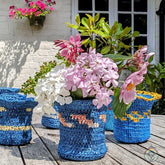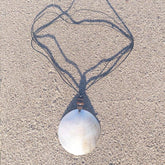 |
 |
 |
 |
Karen Hilltribe Shoulder Bag, Light Pink
- £21.20 GBP
- £21.20 GBP
- Unit price
- per
Couldn't load pickup availability
Free Shipping
Free standard shipping on orders over £50
Description
xDescription
The Karen people traditionally make their own clothes and shoulder bags which are hand woven by the women sitting on the ground using a traditional back strap loom.
Patterns are handed down from generation to generation. Some natural dyes are used, produced from tree and plant extracts and artificial dyes are also used to create the brighter colours.
Weaving is a skill that remains important to the Karen culture.
These shoulder bags are used by men, women and children alike to carry all manner of things from food produce to school books. What we like about these bags is that they are super-strong and durable. The reason for this is that there is no seam at the bottom of the bag or shoulder strap.
The whole bag is made from one piece of woven fabric and the only seam is down one side of the bag. This seam is beautifully embroidered over to blend in with the bag decorations/colours. The shoulder strap hip length, wide and comfortable.
Through the careful preservation of this craftsmanship, these communities are today able to sell their handcrafted creations to bring in much needed additional income. This is giving more and more families access to basic rights such as being able to fund healthcare, put enough food on the table and send their children to school.
Handcrafted futures Through buying a piece today you are not only helping to keep a tradition alive but also supporting sustainable income generation.
You might also like:
. Shoppers
. Travel Bags
Specifications
- 100% sustainable materials
- 100% hand crafted
Story
The Lamphun Province in upper northern Thailand is the home to the Karen people surrounded by lush countryside punctuated by rice fields and orchards and situated between two idyllic mountain ranges. The district is 670 km from Bangkok and 26 km from Chaing Mai.
All our Karen hand woven materials are lovingly handmade by villagers within the Lamphun District. An area, where for generations Karen families have been passing down the skills to create beautifully traditional cloth embroidery.
It is home to many neighbouring Karen communities who have developed an innovative way to overcome adversity and bring in a sustainable income.
Related Products
- £21.20 GBP
- £21.20 GBP
- Unit price
- per
- £21.20 GBP
- £21.20 GBP
- Unit price
- per
- £21.20 GBP
- £21.20 GBP
- Unit price
- per
- £21.20 GBP
- £21.20 GBP
- Unit price
- per
- £21.20 GBP
- £21.20 GBP
- Unit price
- per
- £21.20 GBP
- £21.20 GBP
- Unit price
- per
- £21.20 GBP
- £21.20 GBP
- Unit price
- per
- £21.20 GBP
- £21.20 GBP
- Unit price
- per
- £21.20 GBP
- £21.20 GBP
- Unit price
- per
- £21.20 GBP
- £21.20 GBP
- Unit price
- per
Recently Viewed Products

- Choosing a selection results in a full page refresh.













